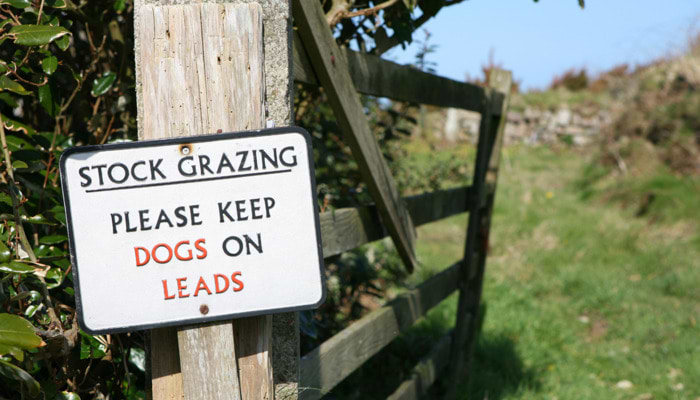
© Joe Gough / Shutterstock.com
Visitors to rural regions of the UK, and especially agricultural areas, should be aware of the Countryside Code. This set of rules was drawn up to ensure everyone living and working in the countryside is treated with respect, so their livelihood isn't negatively impacted by tourism. The original code evolved over the years, from the 1930s onwards, as a result of the work of various organisations. The first Countryside Code was published in booklet form in 1951. All the different versions were brought together to produce the most widely accepted version, published by the Countryside Commission in 1981. With updated advice on how to enjoy the countryside and respect its lifestyle and workforce; the latest version was published on 1st April 2021. It was launched by Natural England and Natural Resources Wales to reflect the fact that more people are enjoying the outdoors than ever before. The revised Countryside Code will help visitors to enjoy the countryside in a respectful and safe way. It was shaped by almost 4,000 responses from rural residents to an online survey asking for their views on best practices for protecting the natural environment. Rural holiday boom In the 12 months before the Covid-19 pandemic prevented travel, people took around 358 million trips to rural locations across Britain. Tourism in predominantly rural areas was worth an estimated £11.5 billion to the economy. While the lockdowns and travel bans reduced visitor numbers in 2020, new research reveals rural destinations are emerging as the most attractive holiday choice. Rural tourism has become one of the alternative choices for both domestic and international tourists in 2021. Its share in the overall tourism market has increased from 10% to 14% and shows no signs of slowing down. People have remained wary of foreign travel in 2021, according to a survey published by Travel Weekly, with 64% of respondents fearing a resurgence of the virus could lead to renewed quarantine regulations. Health fears were still deterring 48% of respondents from taking a holiday abroad. Countryside Code changes Changes included in the 2021 revised Countryside Code aim to help create a welcoming environment, while deterring activities that will damage the rural environment. For example, it advises smiling and saying hello to visitors, with the catchphrases, "Be nice, say hello, share the space," and, "Enjoy your visit, have fun, make a memory." It also contains a reminder not to feed wild animals, livestock or horses. Visitors must not stray from marked footpaths, even if they're muddy, to protect wildlife, farm animals and crops. The code provides information on how to get permission to do outdoor activities, such as swimming outdoors. There are clearer rules for people with dogs, reminding them to clean up after their pet and to put the bag in a public waste bin, or to carry it until they can find a bin. It also emphasises the importance of keeping dogs under proper control, keeping them on a lead if there is livestock about, to prevent pets from worrying sheep and other farm animals. When dogs chase sheep, the stress can cause the animal to die, while pregnant ewes can suffer a miscarriage. When sheep flee from loose dogs, they can be seriously injured or even killed in their panic to escape. This can also cause damage to fences and other field boundaries. The code is written in a "refreshed tone of voice", so it comes across more like a friendly guide, rather than a set of rules. This is aimed at recognising the benefits on mental and physical health of spending time surrounded by nature. The guide also makes it clear that the rules apply to different natural places including waterways, parks and coastal areas, as well as the countryside. What issues do visitors cause for farmers? While loose dogs worrying sheep is a major concern for farmers, countryside visitors can also inadvertently cause other problems. Walkers sometimes leave gates open, despite farmers displaying "keep gate closed" signs. This can lead to livestock escaping and wandering onto roads or getting lost. Sometimes, dry stone walls are damaged by people trying to climb over them. In some areas, voluntary bodies, such as the National Trust, maintain the walls and footpaths on their land. However, for farmers relying on walls to fence off their property and livestock, careless damage can be a source of expense and frustration. Increased noise from tourists can disturb farm animals, particularly at certain times of year, such as during the lambing season. Sometimes, farmers have been known to temporarily restrict access to walkers at these times for the animals' safety. In these situations, countryside rangers try to liaise with the different land users to minimise the conflict, while rural visitor centre staff try to educate the public about the rural Outdoor Access Code to help farmers work in peace. The aim of guidelines like the Countryside Code is to enable the farming community and rural visitors to exist side-by-side without conflict, as both sectors are important to the rural economy and to the UK in general. Different symbols There are various countryside symbols that you should be aware of when visiting rural areas. A yellow arrow signifies a footpath for walkers and mobility aid users: a blue arrow signifies a bridleway, providing a right of way for walkers, people who use mobility aids, cyclists and horse riders: an acorn symbol signposts a National Trail that has been created for walkers - horse-riding and cycling is possible on some: a round brown symbol depicting a person walking over hills means it's an area of Open Access, where people can explore away from the paths. This can include areas of mountains, moorland, heaths, coastal areas and registered common land. Before embarking on a visit to the countryside, make sure you understand the Countryside Code in order to enjoy your visit without creating a negative impact on the local workers and industries.




